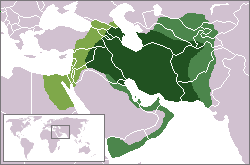Zurvanism
Zurvanism was a branch of Zoroastrianism that emerged during the Sassanian Empire period, emphasizing Zurvan ("Time") as the supreme deity. This religious movement is considered a heretical sect within Zoroastrianism by mainstream scholars, as it diverges significantly from the orthodox teachings centered around Ahura Mazda, the wise lord, and the eternal battle between the forces of good and evil.
Beliefs and Practices[edit | edit source]
Zurvanism introduced the concept of a singular god of time, Zurvan, as the parent of the twin brothers Ahura Mazda (Ohrmazd) and Angra Mainyu (Ahriman). In this cosmology, Zurvan was a neutral god, embodying both good and evil, from whom the two opposing forces of the universe were born. This dualistic nature of creation led to the belief that both good and evil originated from the same source, a stark contrast to the traditional Zoroastrian dualism that strictly separated good and evil.
The sect's theology posited that the material world was a battleground for the cosmic struggle between Ahura Mazda, the god of light and goodness, and Angra Mainyu, the god of darkness and evil. Zurvanism emphasized predestination, suggesting that the end of the world would come when time itself ended, leading to a final judgment where good would triumph over evil.
Zurvanite rituals and practices likely mirrored those of mainstream Zoroastrianism, including the sacred fire ceremonies and the reverence of natural elements such as water and earth. However, specific details about their rituals are scarce, as much of the knowledge about Zurvanism comes from external sources and critiques by orthodox Zoroastrians.
Historical Context[edit | edit source]
Zurvanism gained prominence during the Sassanian period, a time of great theological debate and religious diversity within the Persian Empire. The reasons for its emergence are not entirely clear, but scholars suggest it may have been an attempt to reconcile the monotheistic and dualistic elements within Zoroastrianism or to provide a more appealing religious framework to the increasingly diverse population of the empire.
Despite its popularity, Zurvanism faced criticism and opposition from orthodox Zoroastrians, who viewed its teachings as a distortion of the original Zoroastrian dualism. The Sassanian clergy, in particular, worked to suppress the Zurvanite doctrine and reaffirm the authority of the traditional Zoroastrian priesthood and teachings.
Decline and Legacy[edit | edit source]
Zurvanism's decline began with the fall of the Sassanian Empire to the Islamic conquests in the 7th century. As the new Islamic rulers established their dominance, Zoroastrianism itself was marginalized, and Zurvanism, as a sect within it, faded into obscurity. However, the influence of Zurvanite thought persisted, contributing to the rich tapestry of Persian religious and philosophical ideas.
The study of Zurvanism today provides valuable insights into the religious dynamics of the Sassanian Empire and the broader context of Middle Eastern religions. It highlights the complexity of Zoroastrianism and its capacity to adapt and evolve in response to internal challenges and external pressures.
Search WikiMD
Ad.Tired of being Overweight? Try W8MD's physician weight loss program.
Semaglutide (Ozempic / Wegovy and Tirzepatide (Mounjaro / Zepbound) available.
Advertise on WikiMD
|
WikiMD's Wellness Encyclopedia |
| Let Food Be Thy Medicine Medicine Thy Food - Hippocrates |
Translate this page: - East Asian
中文,
日本,
한국어,
South Asian
हिन्दी,
தமிழ்,
తెలుగు,
Urdu,
ಕನ್ನಡ,
Southeast Asian
Indonesian,
Vietnamese,
Thai,
မြန်မာဘာသာ,
বাংলা
European
español,
Deutsch,
français,
Greek,
português do Brasil,
polski,
română,
русский,
Nederlands,
norsk,
svenska,
suomi,
Italian
Middle Eastern & African
عربى,
Turkish,
Persian,
Hebrew,
Afrikaans,
isiZulu,
Kiswahili,
Other
Bulgarian,
Hungarian,
Czech,
Swedish,
മലയാളം,
मराठी,
ਪੰਜਾਬੀ,
ગુજરાતી,
Portuguese,
Ukrainian
Medical Disclaimer: WikiMD is not a substitute for professional medical advice. The information on WikiMD is provided as an information resource only, may be incorrect, outdated or misleading, and is not to be used or relied on for any diagnostic or treatment purposes. Please consult your health care provider before making any healthcare decisions or for guidance about a specific medical condition. WikiMD expressly disclaims responsibility, and shall have no liability, for any damages, loss, injury, or liability whatsoever suffered as a result of your reliance on the information contained in this site. By visiting this site you agree to the foregoing terms and conditions, which may from time to time be changed or supplemented by WikiMD. If you do not agree to the foregoing terms and conditions, you should not enter or use this site. See full disclaimer.
Credits:Most images are courtesy of Wikimedia commons, and templates, categories Wikipedia, licensed under CC BY SA or similar.
Contributors: Prab R. Tumpati, MD

